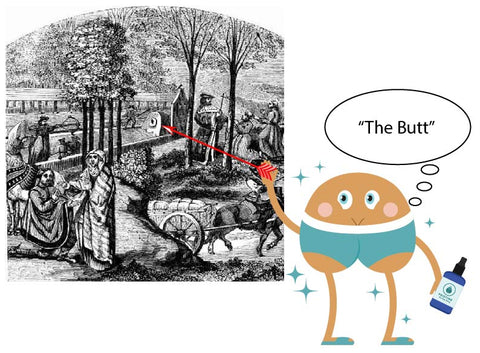We are deep into the toilet scene. And while there are hundreds of interesting facts about the toilet, the bathroom, and the behind on the internet, the following 9 facts received a unanimous vote to be awarded the prized title of "The 9 Most Interesting Toilet Facts on the Internet."

1. A 1,500 year old human ate an entire rattlesnake raw, and we know because of poop.
Scientists analyzed 1,500 year old fossilized human waste to reveal a shocking discovery - scales, bones, and a fang of a venomous snake (most likely a diamondback rattlesnake or copperhead). Here is a closeup of the fang that was discovered. The snake was eaten whole, and the absence of char marks on the scales indicates that the snake was consumed raw. While the motives remain unclear, it has been suggested that this could have been a ceremonial practice or even a bet (making our modern bets seem rather tame)!
Some other interesting items found in the fossilized stool included evidence of yucca pollen and an unskinned and uncooked rodent.
Read more about the surprising discovery.

2. You can find medieval toilets without going inside a castle because they stick straight out of the wall.
"Privy chambers," "garderobes," and "neccessariums" - all medieval names for the toilet room. By medieval times, privy chambers were being incorporated into the castle architecture. They can typically be identified projecting out from the castle wall. They are often strategically positioned so that waste would fall through a hole in the privy chamber and directly into the castle moat (or a river below, if more convenient 🤢).
Interestingly, the privy chamber could prove one of the more vulnerable design features of a castle. In a 13th Century battle in France, attackers crawled into a waste shaft extending from a privy chamber to gain entry to the castle.
Now it's time for some practice. Can you find the privy chamber on this castle?

3. The phrase "the butt of a joke" comes from shooting arrows in the 13th century.
The phrase has its origins in archery in the 13th Century. The French word but means "goal" and was used to describe the "target" of the arrow. By the 14th century, the word had changed to include turf covered hills or mounds behind the archery targets (identified by Sparkle Butt in the picture above and having a shape quite similar to the "butt" with which we are familiar). There were usually two butts on an archery range, so an archer might speak of the "pair of butts." By the 1600's, the term "butt" had already developed its current meaning of the "target of a joke." An archery shooting field is still known as a "butt" to this day.
If we have left you wanting more, click here to see a pair of Medieval butts.

4. "Leave It To Beaver" took a big risk by showing the first toilet on TV.
In 1957, hit series "Leave It to Beaver" became the first show to display a portion of a toilet on TV. In the episode, brothers Wally and Beaver decided to keep a pet alligator in the toilet tank to hide it from their parents. The network refused to approve the episode in its original form because displaying anything bathroom-related was a no-no, especially the porcelain throne, which at the time had yet to make an appearance in TV history. A compromise was finally reached to show only the toilet tank, not the toilet itself, so the episode was permitted to air.
Click here to see an image of the toilet's first television appearance in history! A 30-second video clip of the toilet's cameo can be found on Facebook here.

5. Early Americans threw foreign objects into toilets at bars (just like modern people).
Early Americans used brick-lined “privy pits” as restrooms. One of the above privy pits was dated to July 10, 1776, less than a week after the Declaration of Independence was signed only two blocks away. Archaeologists also determined that these privy pits were located near a tavern, which made for some interesting artifacts uncovered in the privy pits. Some of the many objects found in the toilets included drinking glasses, punch bowls, smoking pipes, liquor bottles, wig curlers, supplies from local tanneries, pieces of pottery, and even an entire window. In total, scientists cataloged 82,000 artifacts found discarded within 12 privy pits.
Here is a picture of some of the glassware and liquor bottles discovered.

6. Ancient Romans drew graffiti on bathroom walls (just like modern people).
Archeologists discovered the ruins of ancient Roman bathrooms when excavating the city of Pompeii, which was destroyed by a volcanic eruption about two millennia ago. Accompanying the bathroom paintings, they found many instances of graffiti - akin to the scribble found on bathroom walls and stall doors today. About two dozen of the instances of graffiti refer to poop, which indicates that potty humor was alive and well in Ancient Rome.
Interestingly, some of the graffiti resembled hotel accommodation "reviews." One Roman complained that the innkeeper had not provided a "chamber pot" (toilet) for the room. This sort of offense seems to warrant a negative review.
Here is a fascinating 2-minute video about graffiti in Pompeii.

7. Art historians discovered a secret pooping man in royal art.
A hidden pooping man was revealed while conservators were cleaning a 17th-century Dutch painting in Queen Elizabeth II's collection. If you've given up on finding the culprit in the picture above, here is a close-up. Dutch art often included people or animals relieving themselves both as a joke and also to remind the viewer of the inspiration for the art - nature!
In another twist of irony, the painting's name is "A Village Fair With a Church Behind."
Click here to learn more about the aptly-named painting.

8. The world's oldest public toilet is 240 Million years old, and it contains tons of poop, literally.
Scientists uncovered a 240 million year old prehistoric "dumping" ground for ancient reptiles known as the "World's Oldest Public Toilet." Some of the fossilized movements weighed as much as several kilograms! Scientists cataloged their findings in a museum of poo (pictured here).
Learn more about this prehistoric toilet to fascinate all of your friends at the water cooler.

9. A Toilet Brush Manufacturer Changed the Holiday Decoration Game in the United States
In the 1930’s, toilet bowl brush manufacturer Addis Housewares Company changed the look of artificial trees and other holiday decorations having plastic bristles. Prior to this, artificial trees were made of metal wires covered in feathers of turkeys, ostrich, swan, or goose feathers. These feathers were often dyed green. The original Addis Company tree was actually manufactured using the same equipment as the company’s toilet brushes. That's right, the original artificial trees were essentially large re-shaped toilet brushes.
Click here to learn more about this innovative invention from the toilet space.







